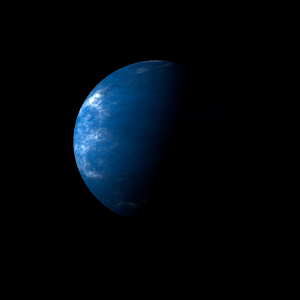|
|
Space Astro
|
Info for exoplanet "Dapal Dys"
| Scientific (actual) data |
|---|
| Name | K2-103 b |
| Planet status | Confirmed |
| Radius | 0.177 |
| Orbital period | 21.1699 |
| Semi major axis | 0.131 |
| Orbit eccentricity | 0.06 |
| Inclination | 89.73 |
| Discovered | 2016 |
| Updated | 2022-02-11 |
| Omega | 338.5 |
| Tconj | 2457170 |
| Tzero tr | 2457120 |
| Publication | Published in a refereed paper |
| Detection type | Primary Transit |
| Radius measurement type | Primary Transit |
| Alternate names | 2MASS J08413848+1738240 b, EPIC 211822797.01, K2-103 b, WISE J084138.46+173823.9 b |
| Star name | EPIC 211822797 |
| Right ascension | 130.41° |
| Declination | 17.64° |
| Mag j | 12.277 |
| Mag h | 11.605 |
| Star distance | 187.19 |
| Star mass | 0.66 |
| Star radius | 0.57 |
| Star sp type | M0 |
| Star age | 0.8 |
| Star temperature | 4148.21 |
| Star alternate names | 2MASS J08413848+1738240, K2-103, WISE J084138.46+173823.9 |
| Wikipedia article | K2-103 b |
Back
| |
| Fictional info (?) |
|---|
| Suggested name | Dapal Dys |
| Planet type | Planet |
| The planet telescopically displays the complete range of phases, similar to Venus and the Moon, as it moves in its inner orbit relative to EPIC 211822797, which reoccurs over the so-called synodic period approximately every 110 days.
The smooth Borealis basin in the northern hemisphere covers 14 percent of the planet and may be a giant impact feature.
The volume of water ice in the south polar ice cap, if melted, would be sufficient to cover the entire planetary surface to a depth of 16 meters.
The outer atmosphere is visibly segregated into several bands at different latitudes, resulting in turbulence and storms along their interacting boundaries. |
| Atmosphere | Carbon dioxide | 98% |
| 2H2O | 0.82% |
| Oxygen | 0.53% |
| Ammonium hydrosulfide (NH4SH) | 0.079% |
| Neon | 6.5E-5% |
| Atmospheric pressure | 0.12 bar |
 |
| No known satellites |
| Google search for Dapal dys |
|
Website by Joachim Michaelis
|
|
|
|